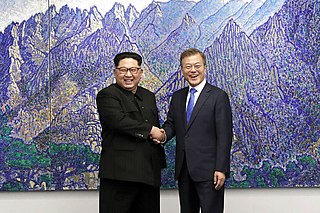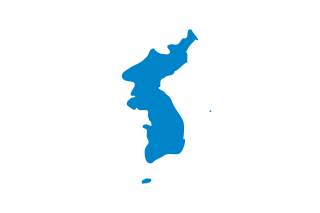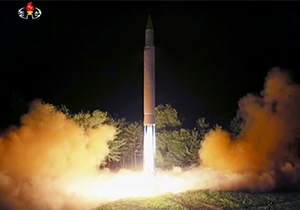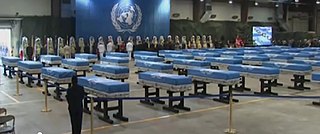 W
WThe April 2018 Inter-Korean summit took place on 27 April 2018 on the South Korean side of the Joint Security Area, between Moon Jae-in, President of South Korea, and Kim Jong-un, Chairman of the Workers' Party of Korea, and Supreme Leader of North Korea. The summit was the third inter-Korean summit – and the first in eleven years. It was also the first time since the end of the Korean War in 1953 that a North Korean leader entered the South's territory; President Moon also briefly crossed into the North's territory.
 W
WThe May 2018 inter-Korean summit was the second inter-Korean summit in 2018. On 26 May, North Korean state chairman Kim Jong-un and South Korean president Moon Jae-in met again in the joint Security Area, this time on the North Korean side in the Inter-Korean Peace House in the Unification Pavilion. The meeting took two hours, and unlike other summits it had not been publicly announced beforehand. Photos released by South Korea's presidential office showed Moon arriving at the northern side of the Panmunjom truce village and shaking hands with Kim's sister, Kim Yo-jong, before sitting down with Kim for their summit. Moon was accompanied by Suh Hoon, Director of the National Intelligence Service of South Korea, while Kim was joined by Kim Yong-chol, a former military intelligence chief who is now a vice chairman of the North Korean ruling party's central committee tasked with inter-Korean relations. The meeting was largely centered around North Korean leader Kim Jong-un's upcoming summit with US President Donald Trump. Kim and Moon also embraced before Moon returned to South Korea. On 27 May, Moon stated in a public address that he and Kim agreed to meet again at "anytime and anyplace" without any formality and that the North Korean leader once again pledged to denuclearize the Korean Peninsula in accordance with the Panmunjom Declaration.
 W
WBalloon propaganda campaigns in Korea include both North and South Korean propaganda leaflet campaigns through the use of balloons as a distribution method since the Korean War. A variety of other contents have also been included with the balloons. Originally, these campaigns were organized by the governments and militaries of the Korean states. Contemporarily, however, they are mainly organized by South Korean non-governmental organizations (NGOs) that regularly involve themselves in balloon release events that aim to send materials censored in North Korea, as well as various other goods, to the North Korean people.
 W
WFor centuries before 1945, Korea had been a unified political entity. The origins of the modern division of Korea trace to the period of Japan's colonial rule over Korea (1910-1945). During World War II, the Allied leaders fighting Japan considered the question of Korea's future after Japan's surrender in the war. The leaders reached an understanding that Korea would be liberated from Japan but would be placed under an international trusteeship until the Koreans would be deemed ready for self-rule. Beyond this rather vague agreement, much about the future of Korea was left uncertain.
 W
WThe Joint Security Area is the only portion of the Korean Demilitarized Zone (DMZ) where North and South Korean forces stand face-to-face. The JSA is used by the two Koreas for diplomatic engagements and, until March 1991, was also the site of military negotiations between North Korea and the United Nations Command (UNC).
 W
WThe Korean conflict is an ongoing conflict based on the division of Korea between North Korea and South Korea, both of which claim to be the sole legitimate government and state of all of Korea. During the Cold War, North Korea was backed by the Soviet Union, China, and its communist allies, while South Korea was backed by the United States and its Western allies. The division of Korea by external powers occurred after World War II had ended, starting in 1945, with the official division in 1948, tensions erupted into the Korean War, which lasted from 1950 to 1953. When the war ended, both countries were devastated, with utter destruction of much of the countries, but the division remained. North and South Korea continued a military standoff, with periodic clashes. The conflict survived the end of the Cold War and continues to this day.
 W
WThe Korean Demilitarized Zone is a strip of land running across the Korean Peninsula. It is established by the provisions of the Korean Armistice Agreement to serve as a buffer zone between North Korea and South Korea. The demilitarized zone (DMZ) is a border barrier that divides the Korean Peninsula roughly in half. It was created by agreement between North Korea, China and the United Nations Command in 1953. The DMZ is 250 kilometres long, and about 4 kilometres wide.
 W
WThe Korean DMZ Conflict, also referred to as the Second Korean War by some, was a series of low-level armed clashes between North Korean forces and the forces of South Korea and the United States, largely occurring between 1966 and 1969 at the Korean DMZ.
 W
WKorean reunification refers to the potential reunification of North Korea and South Korea into a single Korean sovereign state. The process towards reunification was started by the June 15th North–South Joint Declaration in June 2000, and was reaffirmed by the Panmunjom Declaration for Peace, Prosperity and Unification of the Korean Peninsula in April 2018, and the joint statement of the United States President Donald Trump and North Korean Chairman Kim Jong-un at the Singapore Summit in June 2018. In the Panmunjom Declaration, the two countries agreed to work towards a peaceful reunification of Korea in the future.
 W
WThe Military Demarcation Line (MDL), sometimes referred to as the Armistice Line, is the land border or demarcation line between North Korea and South Korea. On either side of the line is the Korean Demilitarized Zone (DMZ). The MDL and DMZ were established by the Armistice.
 W
WThe Neutral Nations Supervisory Commission (NNSC) was established by the Korean Armistice Agreement signed 27 July 1953, declaring an armistice in the Korean War. It is, with the Military Armistice Commission, part of the mechanism regulating the relations between the Democratic People's Republic of Korea and the Republic of Korea.
 W
WThe 2017–18 North Korea crisis was a period of heightened tension between North Korea and the United States throughout 2017, which began when North Korea conducted a series of missile and nuclear tests that demonstrated the country's ability to launch ballistic missiles beyond its immediate region and suggested that North Korea's nuclear weapons capability was developing at a faster rate than had been assessed by the U.S. intelligence community.
 W
WThe recovery of US human remains from the Korean War has continued since the end of the war.
 W
WThe United Nations Command Military Armistice Commission (UNCMAC) was established in July 1953 at the end of the Korean War to supervise the Korean Armistice Agreement, and which has been operating ever since.
 W
WThe United Nations Memorial Cemetery in Korea, located at Tanggok in the Nam District, City of Busan, Republic of Korea, is a burial ground for United Nations Command (UNC) casualties of the Korean War. It contains 2,300 graves and is the only United Nations cemetery in the world. Laid out over 14 hectares, the graves are set out in 22 sites designated by the nationalities of the buried servicemembers.